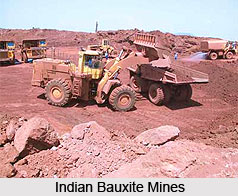 A rock mainly comprising minerals that are hydrous is aluminum oxides. These minerals are gibbsite, boehmite, and diaspore. Bauxite is a weathering product of aluminous rock that results from intense leaching in tropical and subtropical areas, a process called laterization. Bauxite deposits are generally found on plateaus in stable areas where they had sufficient geologic time to form and were protected from erosion. Bauxite is the primary ore of aluminum. The two types of bauxites that are used commercially as aluminum ores are laterite and karst. Lateritic bauxites constitute more than three-fourths of the world`s bauxite resources.
A rock mainly comprising minerals that are hydrous is aluminum oxides. These minerals are gibbsite, boehmite, and diaspore. Bauxite is a weathering product of aluminous rock that results from intense leaching in tropical and subtropical areas, a process called laterization. Bauxite deposits are generally found on plateaus in stable areas where they had sufficient geologic time to form and were protected from erosion. Bauxite is the primary ore of aluminum. The two types of bauxites that are used commercially as aluminum ores are laterite and karst. Lateritic bauxites constitute more than three-fourths of the world`s bauxite resources.
Karstic bauxites are formed on a carbonate ground and are concentrated in sinkholes and solution depressions on the surface of carbonate rocks. Bauxite used to produce alumina is called metallurgical grade; approximately 90% of the world`s production is for this purpose. Other major uses are in refractories, abrasives, chemicals, and aluminous cements. The compositional requirements are much more rigid for these uses. The alumina content must be higher, and the iron, silica, and titanium contents significantly lower, than for metallurgical-grade bauxite. World resources of bauxite are many tens of billions of tons, so an adequate supply is assured for hundreds of years. Bauxite does not require complex processing because most of the bauxite mined is of an acceptable grade or can be improved by a relatively simple and inexpensive process of removing clay.



















